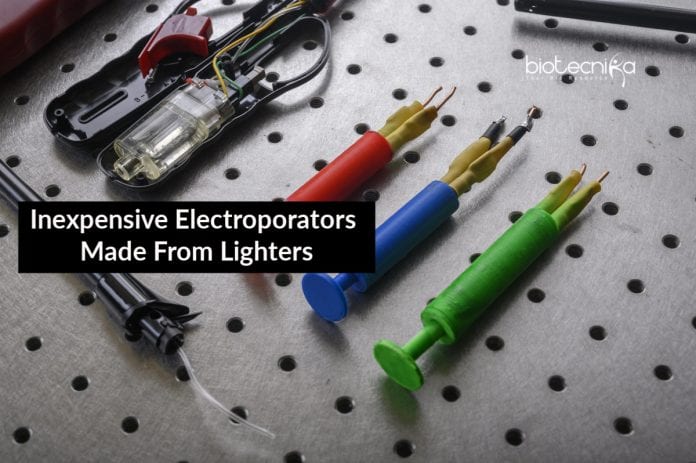Electroporator from Lighter – Inexpensive and Easy to Handle
Researchers developed an electroporator from inexpensive components, a device that applies a jolt of electricity to open cell walls temporarily. The components included a piezoelectric crystal taken from a butane lighter.
Plans for the device, known as the ElectroPen, are being made available, along with the files necessary for creating a 3D-printed casing.
The researchers plan to make available the Electropens for high schools, laboratories that are budget conscious, and for those working in remote locations without access to electricity to perform electroporation. M. Saad Bhamla, an assistant professor at Georgia Tech’s School of Chemical and Biomolecular Engineering, said, this is an example of looking for ways to advance scientific research overcoming economic limitations.
The researchers detailed the method for constructing the ElectroPen in the journal of PLOS Biology on January 10. The electroporators made from lighter called ElectroPen is capable of producing short busts of more than 2000 volts required for different laboratory tasks and was sponsored by the National Institutes of Health and the National Science Foundation.
The primary function of the cell membrane is to act as a protective border that shelters the inside cell mechanisms from the outside
environment. But a short jolt of electricity could temporarily open up the membrane and allow foreign molecules to enter. This process is called electroporation, which has been used for various tasks like bacterial detection and genetic engineering for decades.Although electroporation is a common technique in molecular biology, they were confined to academic or professional labs due to its high cost and need for electric source. With the help of Assistant Professor Mark Styczynski, Lambert High School teacher Janet Standeven and collaborators like Yan Zhang and Soham Sinha, Bhamla and undergraduate student Gaurav Byagathvalli set out to change that.
When the researchers decided to tackle the issue, they started exploring the technology of electroporators. This helped them to understand why the electroporators are so bulky and expensive. Since the 1980s, when the electroporators were initially discovered, their design remained almost the same. This sparked a question in researchers if they could achieve the same at a lesser cost. They started uncovering the mysteries behind this very common tool when they identified a lighter that could produce these high voltages through piezoelectricity.
The newly developed electroporator consisted of a piezoelectric lighter crystal along with a heat shrinking wire insulator, aluminum tape, and a copper-plated wire. The piezoelectric lighter crystal produced a brief current when applied pressure. A 3D-printed casing was also developed that holds it all together and acts as an activator. The device could be assembled in 15 minutes provided all the parts on hand.
The ElectroPen cannot replace the electroporator used in academic laboratories, which costs thousands of dollars and could be used in a broad range of cell mixtures. But it could still be used for tasks that do not require high volumes.
The researchers found the lighter crystals that produced consistent voltage using a spring-based mechanism. The team used a high-speed camera at 1,057 frames per second to view device mechanics in slow motion in order to understand more about how the lighters function.
Independent of the amount of force applied by the user, the piezoelectric crystal generates a consistently high voltage. This is the fundamental reason behind the working of the device. The team found that the hammer in the lighter is capable of achieving 3000 G’s acceleration, which explains the high burst of voltage generated.
They tested the ElectroPen on E.coli samples to infiltrate the cells with a chemical that makes the cells fluorescent, illuminating the cell parts and making it easy to identify. A similar method could be used to detect the presence of bacterial cells in a laboratory or remote field operations.
The team also shipped the ElectroPens to students at high schools and universities to evaluate whether the device is easy to use. The new electroporators from lighter were also able to successfully obtain fluorescence validating the easiness of handling the device by students across the globe.
The future plan of the research is to test a broader range of lighters looking for consistent voltages across a broader range, to create ElectroPens of varying voltages.































I want more information about the details of jobs